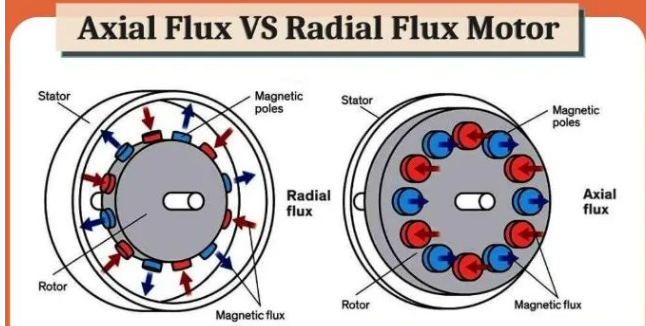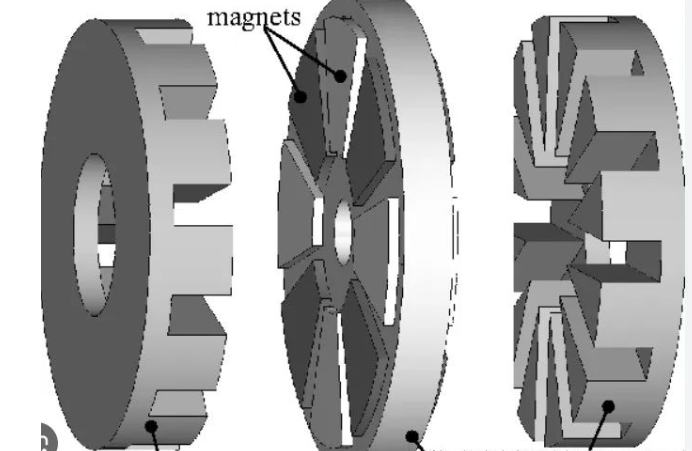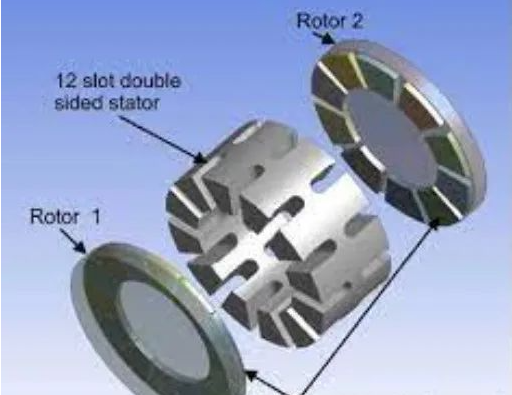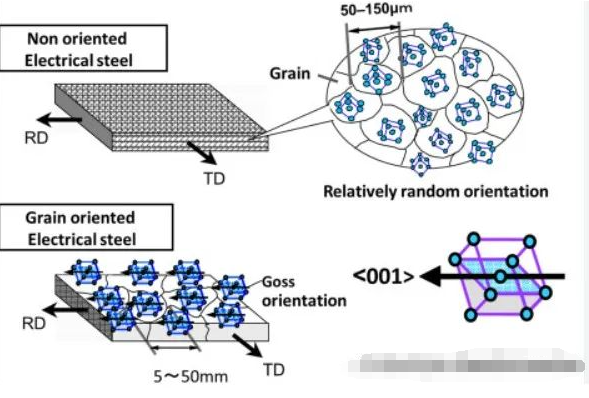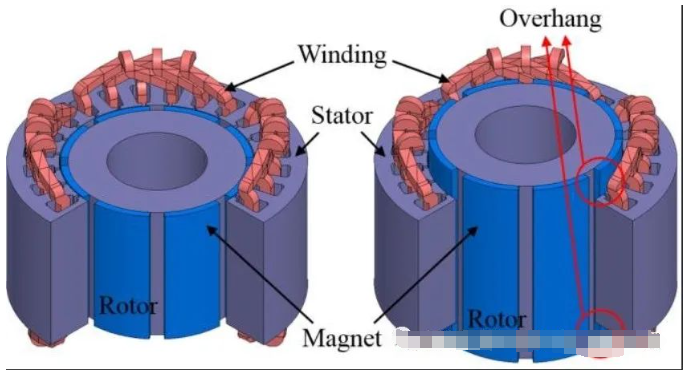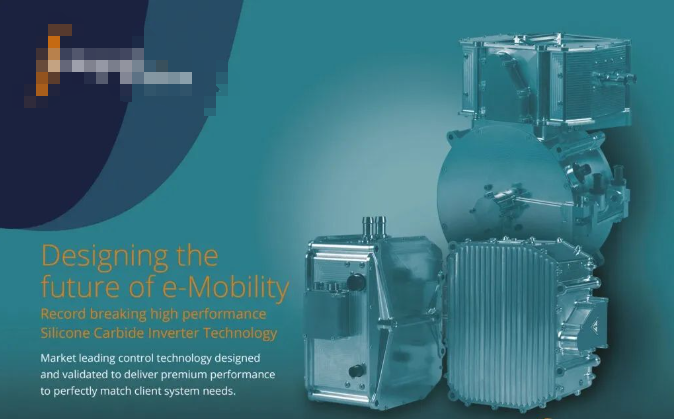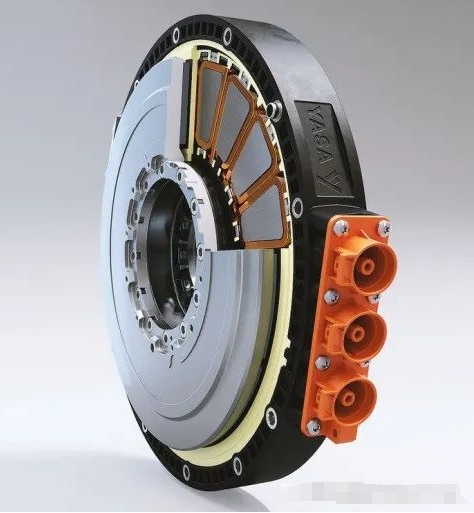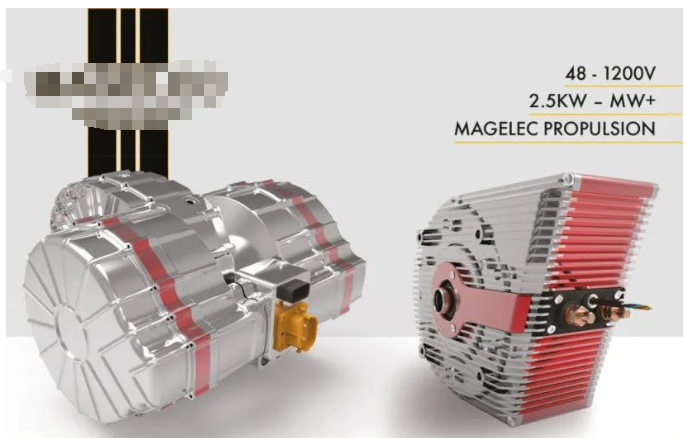Compared to radial flux motors, axial flux motors have many advantages in electric vehicle design. For example, axial flux motors can change the design of the powertrain by moving the motor from the axle to the inside of the wheels.
1.Axis of power
Axial flux motors are receiving increasing attention (gain traction). For many years, this type of motor has been used in stationary applications such as elevators and agricultural machinery, but over the past decade, many developers have been working to improve this technology and apply it to electric motorcycles, airport pods, cargo trucks, electric vehicles, and even airplanes.
Traditional radial flux motors use permanent magnets or induction motors, which have made significant progress in optimizing weight and cost. However, they face many difficulties in continuing to develop. Axial flux, a completely different type of motor, may be a good alternative.
Compared to radial motors, the effective magnetic surface area of axial flux permanent magnet motors is the surface of the motor rotor, not the outer diameter. Therefore, in a certain volume of motor, axial flux permanent magnet motors can usually provide greater torque.
Axial flux motors are more compact; Compared to radial motors, the axial length of the motor is much shorter. For internal wheel motors, this is often a crucial factor. The compact structure of axial motors ensures higher power density and torque density than similar radial motors, thus eliminating the need for extremely high operating speeds.
The efficiency of axial flux motors is also very high, usually exceeding 96%. This is thanks to the shorter, one dimensional flux path, which is comparable or even higher in efficiency compared to the best 2D radial flux motors on the market.
The length of the motor is shorter, usually 5 to 8 times shorter, and the weight is also reduced by 2 to 5 times. These two factors have changed the choice of electric vehicle platform designers.
2. Axial flux technology
There are two main topologies for axial flux motors: dual rotor single stator (sometimes referred to as torus style machines) and single rotor dual stator.
Currently, most permanent magnet motors use radial flux topology. The magnetic flux circuit starts with a permanent magnet on the rotor, passes through the first tooth on the stator, and then flows radially along the stator. Then pass through the second tooth to reach the second magnetic steel on the rotor. In a dual rotor axial flux topology, the flux loop starts from the first magnet, passes axially through the stator teeth, and immediately reaches the second magnet.
This means that the flux path is much shorter than that of radial flux motors, resulting in smaller motor volumes, higher power density and efficiency at the same power.
A radial motor, where the magnetic flux passes through the first tooth and then returns to the next tooth through the stator, reaching the magnet. Magnetic flux follows a two-dimensional path.
The magnetic flux path of an axial magnetic flux machine is one-dimensional, so grain oriented electrical steel can be used. This steel makes it easier for the flux to pass through, thereby improving efficiency.
Radial flux motors traditionally use distributed windings, with up to half of the winding ends not functioning. The coil overhang will result in additional weight, cost, electrical resistance, and more heat loss, forcing designers to improve the winding design.
The coil ends of axial flux motors are much less, and some designs use concentrated or segmented windings, which are completely effective. For segmented stator radial machines, the rupture of the magnetic flux path in the stator can bring additional losses, but for axial flux motors, this is not a problem. The design of the coil winding is the key to distinguishing the level of suppliers.
3. Development
Axial flux motors face some serious challenges in design and production, despite their technological advantages, their costs are far higher than those of radial motors. People have a very thorough understanding of radial motors, and manufacturing methods and mechanical equipment are also readily available.
One of the main challenges of axial flux motors is to maintain a uniform air gap between the rotor and stator, as the magnetic force is much greater than that of radial motors, making it difficult to maintain a uniform air gap. The dual rotor axial flux motor also has heat dissipation issues, as the winding is located deep within the stator and between the two rotor discs, making heat dissipation very difficult.
Axial flux motors are also difficult to manufacture for many reasons. The dual rotor machine using a dual rotor machine with a yokes topology (i.e. removing the iron yoke from the stator but retaining the iron teeth) overcomes some of these problems without expanding the motor diameter and magnet.
However, removing the yoke brings new challenges, such as how to fix and position individual teeth without a mechanical yoke connection. Cooling is also a greater challenge.
It is also difficult to produce the rotor and maintain the air gap, as the rotor disc attracts the rotor. The advantage is that the rotor discs are directly connected through a shaft ring, so the forces cancel each other out. This means that the internal bearing does not withstand these forces, and its only function is to keep the stator in the middle position between the two rotor discs.
Double stator single rotor motors do not face the challenges of circular motors, but the design of the stator is much more complex and difficult to achieve automation, and the related costs are also high. Unlike any traditional radial flux motor, axial motor manufacturing processes and mechanical equipment have only recently emerged.
4. Application of electric vehicles
Reliability is crucial in the automotive industry, and proving the reliability and robustness of different axial flux motors to convince manufacturers that these motors are suitable for mass production has always been a challenge. This has prompted axial motor suppliers to carry out extensive validation programs on their own, with each supplier demonstrating that their motor reliability is no different from traditional radial flux motors.
The only component that can wear out in an axial flux motor is the bearings. The length of the axial magnetic flux is relatively short, and the position of the bearings is closer, usually designed to be slightly “over dimensioned”. Fortunately, the axial flux motor has a smaller rotor mass and can withstand lower rotor dynamic shaft loads. Therefore, the actual force applied to the bearings is much smaller than that of the radial flux motor.
Electronic axle is one of the first applications of axial motors. The thinner width can encapsulate the motor and gearbox in the axle. In hybrid applications, the shorter axial length of the motor in turn shortens the total length of the transmission system.
The next step is to install the axial motor on the wheel. In this way, power can be directly transmitted from the motor to the wheels, improving the efficiency of the motor. Due to the elimination of transmissions, differentials, and driveshafts, the complexity of the system has also been reduced.
However, it seems that standard configurations have not yet appeared. Each original equipment manufacturer is researching specific configurations, as the different sizes and shapes of axial motors can alter the design of electric vehicles. Compared to radial motors, axial motors have a higher power density, which means smaller axial motors can be used. This provides new design options for vehicle platforms, such as the placement of battery packs.
4.1 Segmented armature
The YASA (Yokeless and Segmented Armature) motor topology is an example of a dual rotor single stator topology, which reduces manufacturing complexity and is suitable for automated mass production. These motors have a power density of up to 10 kW/kg at speeds of 2000 to 9000 rpm.
Using a dedicated controller, it can provide a current of 200 kVA for the motor. The controller has a volume of approximately 5 liters and weighs 5.8 kilograms, including thermal management with dielectric oil cooling, suitable for axial flux motors as well as induction and radial flux motors.
This allows electric vehicle original equipment manufacturers and first tier developers to flexibly choose the appropriate motor based on the application and available space. The smaller size and weight make the vehicle lighter and have more batteries, thereby increasing the boost of the range.
5. Application of electric motorcycles
For electric motorcycles and ATVs, some companies have developed AC axial flux motors. The commonly used design for this type of vehicle is DC brush based axial flux designs, while the new product is an AC, fully sealed brushless design.
The coils of both DC and AC motors remain stationary, but the dual rotors use permanent magnets instead of rotating armatures. The advantage of this method is that it does not require mechanical reversing.
The AC axial design can also use standard three-phase AC motor controllers for radial motors. This helps to reduce costs, as the controller controls the current of torque, not speed. The controller requires a frequency of 12 kHz or higher, which is the mainstream frequency of such devices.
The higher frequency comes from the lower winding inductance of 20 µ H. The frequency can control the current to minimize current ripple and ensure a sinusoidal signal as smooth as possible. From a dynamic perspective, this is a great way to achieve smoother motor control by allowing for rapid torque changes.
This design adopts a distributed double-layer winding, so the magnetic flux flows from the rotor to another rotor through the stator, with a very short path and higher efficiency.
The key to this design is that it can operate at a maximum voltage of 60 V and is not suitable for higher voltage systems. Therefore, it can be used for electric motorcycles and L7e class four-wheeled vehicles such as Renault Twizy.
The maximum voltage of 60 V allows the motor to be integrated into mainstream 48 V electrical systems and simplifies maintenance work.
The L7e four-wheel motorcycle specifications in the European Framework Regulation 2002/24/EC stipulate that the weight of vehicles used for transporting goods does not exceed 600 kilograms, excluding the weight of batteries. These vehicles are allowed to carry no more than 200 kilograms of passengers, no more than 1000 kilograms of cargo, and no more than 15 kilowatts of engine power. The distributed winding method can provide a torque of 75-100 Nm, with a peak output power of 20-25 kW and a continuous power of 15 kW.
The challenge of axial flux lies in how copper windings dissipate heat, which is difficult because heat must pass through the rotor. The distributed winding is the key to solving this problem, as it has a large number of pole slots. In this way, there is a larger surface area between the copper and the shell, and heat can be transferred to the outside and discharged by a standard liquid cooling system.
Multiple magnetic poles are key to utilizing sinusoidal wave forms, which help reduce harmonics. These harmonics are manifested as heating of the magnets and core, while copper components cannot carry away the heat. When heat accumulates in magnets and iron cores, efficiency decreases, which is why optimizing the waveform and heat path is crucial for motor performance.
The design of the motor has been optimized to reduce costs and achieve automated mass production. An extruded housing ring does not require complex mechanical processing and can reduce material costs. The coil can be directly wound and a bonding process is used during the winding process to maintain the correct assembly shape.
The key point is that the coil is made of standard commercially available wire, while the iron core is laminated with standard laid off the shelf transformer steel, which simply needs to be cut into shape. Other motor designs require the use of soft magnetic materials in core lamination, which may be more expensive.
The use of distributed windings means that the magnetic steel does not need to be segmented; They can be simpler shapes and easier to manufacture. Reducing the size of magnetic steel and ensuring its ease of manufacturing has a significant impact on reducing costs.
The design of this axial flux motor can also be customized according to customer requirements. Customers have customized versions developed around basic design. Then manufactured on a trial production line for early production verification, which can be replicated in other factories.
Customization is mainly because the performance of the vehicle depends not only on the design of the axial magnetic flux motor, but also on the quality of the vehicle structure, battery pack, and BMS.
Post time: Sep-28-2023


